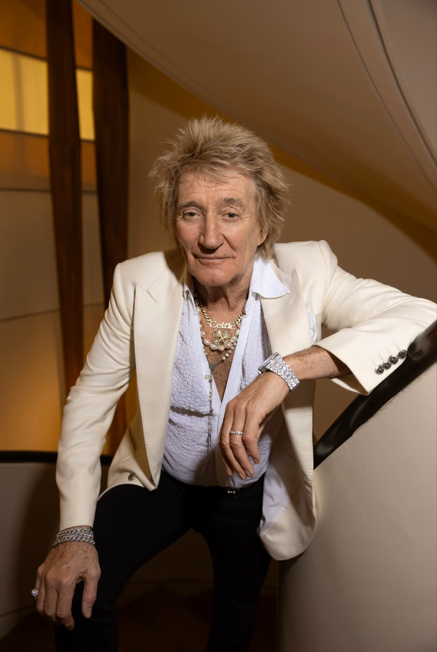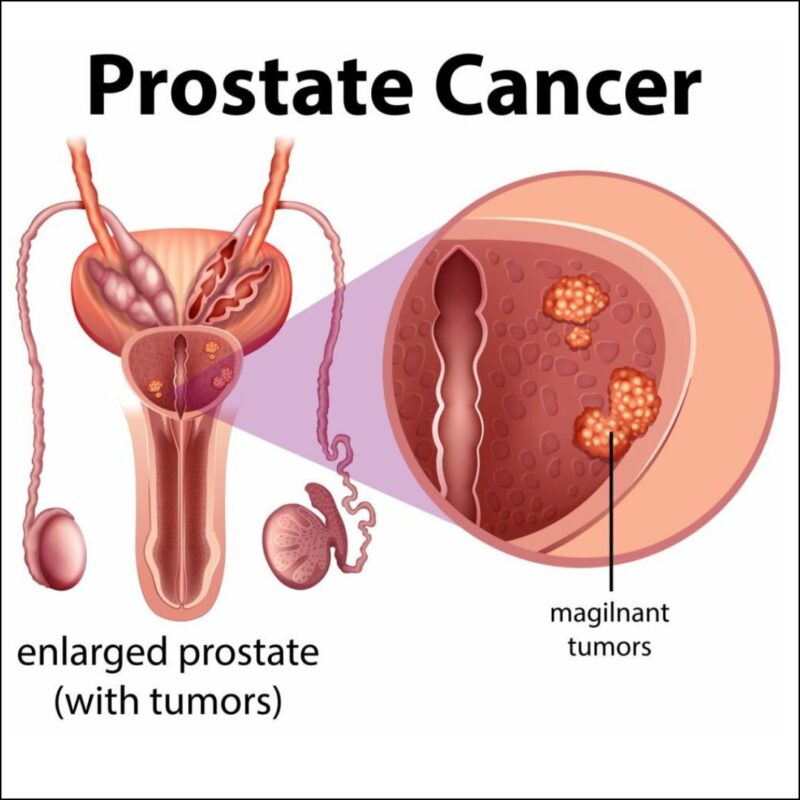Rod Stewart (Sir Roderick David Stewart CBE), born on January 10, 1945, is a celebrated British rock and pop singer known for his distinctive raspy voice and an illustrious career spanning over five decades. With more than 120 million records sold, he is one of the best-selling music artists globally, famous for hits like “Maggie May” and “Do Ya Think I’m Sexy?” His music blends rock, folk, and soul, influencing generations of musicians.In 2016, Stewart was diagnosed with prostate cancer, a battle he initially kept private.

Rod Stewart poses for a portrait on Tuesday, Feb. 7, 2024, in New York. (Photo by Matt Licari/Invision/AP)
How Did Rob Stewart Get Diagnosed with Prostate Cancer?
In 2016, Sir Rod Stewart was diagnosed with prostate cancer during a routine medical check-up, a discovery that he initially kept private. The diagnosis came after he underwent a prostate-specific antigen (PSA) test, which indicated elevated levels.
Symptoms
He did not experience significant symptoms at the time, his proactive approach to health led him to seek regular screenings, highlighting the importance of routine medical check-ups in early cancer detection.
Stewart described the news as a “shock.” In an interview, he reflected on the fear and vulnerability he felt, stating,
“Needless to say, it was a shock… when you are so close to something that is potentially life-threatening, you tend to get your life in perspective.”
This realization prompted him to reassess his priorities and appreciate life more deeply. Stewart’s initial response to his diagnosis involved grappling with fear and uncertainty. He admitted feeling “fearful, vulnerable to a degree that I never had before,” a common reaction to serious health challenges. When it came to sharing the news, Stewart and his wife, Lady Penny Lancaster, kept it private for nearly three years. Penny later revealed they told their older children first, explaining, “We told the older ones… It would be too much for them [the younger ones] to understand.” This approach reflected their desire to manage the emotional impact on their family.
What was the Prognosis?
Sir Rod Stewart’s prognosis following his prostate cancer diagnosis was cautiously optimistic due to the early detection of the disease.The prognosis for prostate cancer can vary significantly based on several factors, including the stage at which it is diagnosed. In Stewart’s case, catching the cancer early was crucial. He later stated,
“I’m in the clear now, simply because I caught it early,”
Age and Risk: The risk of developing prostate cancer increases with age. About 1 in 8 men will be diagnosed with prostate cancer in their lifetime. It is rare in men under 40, but the risk rises significantly after age 50. Over 60% of prostate cancer cases are diagnosed in men aged 65 or older (American Cancer Society).
Survival Rates: Prostate cancer has a relatively high survival rate, especially when detected early. The 5-year relative survival rate for localized or regional prostate cancer is almost 100%. However, if the cancer spreads to distant parts of the body, the survival rate drops to about 30% (National Cancer Institute).
What Treatments Did Rod Stewart Undergo?
Sir Rod Stewart’s treatment plan for prostate cancer involved a three-month intensive course of radiation therapy. This approach was necessary because his cancer was aggressive and had spread beyond the prostate gland, making surgical removal unfeasible. His wife, Lady Penny Lancaster, explained that the treatment required Stewart to visit a London hospital daily for radiation sessions, which he managed alongside his busy music career. His famous quote,
“Guys, you’ve got to really go to the doctor… Finger up the bum, no harm done,”
reflects his humorous approach to destigmatizing prostate exams.
Radiation Therapy
Radiation therapy uses high-energy rays to target and kill cancer cells while minimizing damage to surrounding healthy tissues. There are two main types of radiation therapy for prostate cancer:
- External Beam Radiation Therapy (EBRT): This involves directing radiation from outside the body toward the prostate.
- Intensity-Modulated Radiation Therapy (IMRT): This advanced form allows for precise targeting of the tumor, adjusting the intensity of radiation to protect nearby organs.
- Stereotactic Body Radiation Therapy (SBRT): This method delivers large doses of radiation in fewer sessions, often completed within a week.
- Brachytherapy: This internal method involves placing radioactive seeds directly into the prostate. It can be used alone or in combination with EBRT for more advanced cases.
How Did Rod Stewart Overcome Prostate Cancer?
Following his diagnosis in 2016, he committed to a healthier diet and maintained regular physical activity, recognizing the importance of wellness in recovery. Throughout his journey, Stewart received unwavering support from his family, particularly his wife, Lady Penny Lancaster, who played a crucial role in helping him cope with the emotional challenges of cancer.
Support from Family and Friends
His wife, Lady Penny Lancaster, was particularly instrumental in providing comfort and encouragement throughout his journey. She openly discussed the challenges they faced together, emphasizing the importance of their bond during such a difficult time.In interviews, Stewart has acknowledged the vital role his family played in helping him through his diagnosis and treatment. He said, “I’m one of the lucky ones,” reflecting on how his loved ones’ support greatly impacted his emotional well-being. Having Penny by his side helped him maintain a positive outlook, as he noted,
Mental and Emotional Challenges
Sir Rod Stewart’s journey through cancer involved navigating significant mental and emotional challenges, including fears of recurrence and vulnerability. However, his positive mindset—bolstered by early detection awareness and strong family support—enabled him to cope effectively with these challenges. His experience has not only shaped his personal outlook but also inspired him to advocate for greater awareness around men’s health issues, demonstrating how resilience can emerge from adversity.
How Did Advocacy and Public Awareness Help?
Sir Rod Stewart has effectively used his platform as a global music icon to raise awareness about prostate cancer, leveraging his personal experience to inform and educate others about the disease. After being diagnosed in 2016 and successfully treated, he has become a passionate advocate for men’s health, particularly emphasizing the importance of early detection through regular screenings.
Public Speaking and Advocacy
Stewart has been involved in campaigns that promote prostate cancer awareness, particularly targeting men over 50. He has advocated for men to request prostate-specific antigen (PSA) tests during routine check-ups. In interviews, he stated, “You can actually go and request to get a PSA blood test,” encouraging proactive health management.
What Is Rod Stewart’s Life Like After Cancer?
Post-treatment, Rod Stewart has continued to thrive both personally and professionally. After successfully battling prostate cancer, which he publicly revealed in 2019, he received the all-clear in July 2022. Stewart remains active in his music career, touring extensively and releasing new albums, such as The Tears of Hercules, while expressing a desire to transition into different musical genres beyond rock.
Ongoing Health Challenges
Stewart actively manages his health by maintaining a rigorous training schedule, working out three to four times a week, even while on tour. This commitment to physical fitness is crucial for his overall well-being and helps him cope with the demands of performing. He has described himself as a “workaholic,” indicating a strong desire to continue performing despite health challenges.
In August 2024, Stewart was diagnosed with strep throat and subsequently contracted COVID-19, which forced him to cancel several concerts. His wife, Lady Penny Lancaster, noted that these health setbacks have raised concerns about the long-term implications for his singing career.Additionally, following medical advice is essential for Stewart as he navigates these health issues. He has been cautioned against overexerting himself vocally during recovery from recent illnesses, as ignoring such advice could lead to chronic damage or complications affecting his voice.
What Causes Prostate Cancer?
Prostate cancer risk is influenced by genetic, hormonal, lifestyle, and environmental factors. Key risk elements include a family history of cancer, older age, higher testosterone levels, poor diet, and obesity. Geographic variations also suggest environmental influences. Prevention strategies include maintaining a healthy diet, regular exercise, and weight management. Genetic testing and individualized screening are recommended for those with higher-risk profiles.
Genetic and Hormonal Factors
Several genetic and hormonal factors influence the risk of prostate cancer. Men with a family history of prostate cancer are at a higher risk, with studies showing that having a first-degree relative (father or brother) with prostate cancer increases the risk by 2-3 times (American Cancer Society, Prostate Cancer Risk Factors).
Additionally, inherited mutations, such as those in the BRCA2 gene, are linked to a higher risk of prostate cancer. Men with BRCA2 mutations are about 2-3 times more likely to develop prostate cancer than those without these mutations (National Cancer Institute, Genetics of Prostate Cancer). Another genetic factor is Lynch Syndrome, a hereditary disorder that increases the risk of several types of cancer, including prostate cancer, with men having a lifetime risk of 7-12% (Genetics Home Reference, Lynch Syndrome). Elevated testosterone levels are also associated with a higher risk of prostate cancer, as high testosterone may promote cancer cell growth, though the relationship is complex and under continued study (Mayo Clinic, Prostate Cancer Risk Factors).
Finally, variations in the androgen receptor gene, which regulates the effects of testosterone, have been linked to an increased risk of prostate cancer, with specific gene variants modifying this risk (Journal of Clinical Oncology, Androgen Receptor Gene Variants and Prostate Cancer Risk).

Lifestyle and Environmental Factors
Several lifestyle and environmental factors can influence the risk of prostate cancer. Diet plays a significant role, with a diet high in red meat and processed foods linked to a 20% increased risk of prostate cancer (American Institute for Cancer Research). In contrast, diets rich in fruits, vegetables, and omega-3 fatty acids may reduce this risk (Journal of the National Cancer Institute). Exercise is another important factor; regular physical activity can lower the risk of prostate cancer by 10-30% (Journal of Clinical Oncology). Smoking is also a risk factor, as smokers have about a 30% higher chance of developing aggressive prostate cancer compared to non-smokers (American Cancer Society, Prostate Cancer Risk Factors).
Finally, environmental exposure to chemicals such as pesticides may increase prostate cancer risk, though this connection is still under investigation (Environmental Health Perspectives).
How Can Prostate Cancer Be Prevented?
Preventive measures for prostate cancer focus on regular screenings, lifestyle adjustments, and dietary changes. Routine medical tests help detect cancers early, while quitting smoking, staying active, and maintaining a healthy weight can lower risk factors. A diet rich in plant-based foods, along with limiting alcohol and red meat, is recommended by cancer research organizations to reduce cancer incidence.
Regular Screenings and Early Detection
Regular PSA (Prostate-Specific Antigen) tests and screenings are essential for early detection, especially for men over 50 or those with a family history of prostate cancer. PSA tests measure the level of a protein in the blood, and elevated levels may indicate prostate issues, including cancer.
Recognizing early symptoms such as difficulty urinating, frequent urination (especially at night), or blood in the urine is crucial. Early-stage prostate cancer often shows minimal symptoms, making regular screenings even more vital. Prompt consultation at the first sign of symptoms can lead to early diagnosis, improving treatment outcomes and reducing the risk of complications.
FAQs
When was Rod Stewart diagnosed with prostate cancer?
Rod Stewart was diagnosed with prostate cancer in February 2016 during a routine check-up.
What type of treatment did Rod Stewart undergo for his prostate cancer?
He underwent a three-month intensive course of radiation therapy because the cancer was aggressive and had spread beyond the prostate gland.
How did Rod Stewart keep his cancer diagnosis private?
Stewart and his family chose to keep the diagnosis private for nearly three years, only revealing it publicly in 2019 during a fundraiser for prostate cancer awareness.
What was the outcome of Rod Stewart’s cancer treatment?
In July 2022, he received the all-clear, indicating that there were no traces of cancer remaining.
What symptoms did Rod Stewart experience that led to his diagnosis?
While specific symptoms were not extensively detailed, it was noted that he had some health concerns that prompted further testing, which eventually led to the discovery of the cancer.
Has Rod Stewart faced any other health issues related to cancer?
Yes, in addition to prostate cancer, he was diagnosed with thyroid cancer in 2019, which he described as a “scary” experience but was successfully treated.
How does Rod Stewart advocate for cancer awareness?
Stewart actively promotes awareness about prostate cancer through public speaking engagements, fundraising events, and by encouraging men to get regular screenings, famously stating, “Guys, you’ve got to really go to the doctor… Finger up the bum, no harm done.”
What impact did his cancer diagnosis have on Rod Stewart’s music career?
Despite his health challenges, Stewart has continued to perform and tour, using his platform to raise awareness about men’s health issues while maintaining his music career.
How has Rod Stewart’s family supported him during his cancer journey?
His wife, Lady Penny Lancaster, has been a significant source of support, helping him cope with the emotional challenges of his diagnosis and treatment.
Has Rod Stewart ever met Queen Elizabeth II?
Yes, Rod Stewart met Queen Elizabeth II when he received his knighthood in 2016. He was honored for his services to music and charity work at a ceremony at Buckingham Palace.
What did Rod Stewart say about receiving his knighthood?
Upon receiving the honor, Stewart expressed gratitude, stating, “I’ve led a wonderful life and have had a tremendous career thanks to the generous support of the great British public. This monumental honor has topped it off and I couldn’t ask for anything more.
Written By Aharon Tsaturyan, MD

